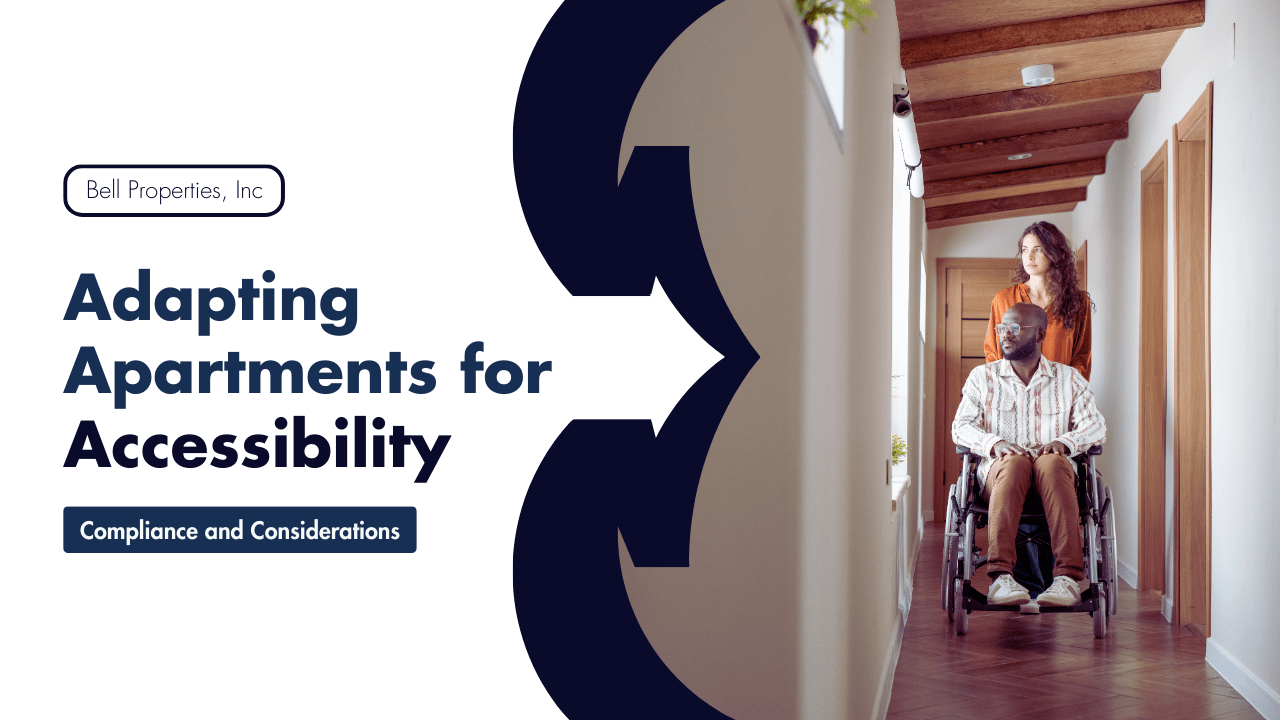For rental property owners in California, ensuring that apartment buildings are accessible to anyone, regardless of ability, is an important part of meeting ADA compliance standards. This is not just a legal requirement—it's an opportunity to make our properties welcoming to all.
Fair housing laws require that there is no discrimination against anyone based on their ability or disability, and adapting an apartment to ensure it’s accessible is an important part of effectively renting out a California property.
Get started on updating any buildings that are not yet up to code. Contact us at Bell Properties and we’ll review the essentials of ADA compliance with you.
Here are some of the ways in which we create and enhance accessibility for individuals with disabilities.
The Basics: Why ADA Compliance Matters {How does this title rank in GA against other similar searches?}

The Americans with Disabilities Act (ADA) is a critical piece of legislation that aims to prevent discrimination against individuals with disabilities. People with disabilities are a protected class in both state and federal fair housing laws. It is against the law to deny these tenants an accommodation or an accessible feature that will allow them to enjoy the property in the same way that anyone else would.
For apartment and rental property owners, adhering to ADA compliance is crucial for several reasons:
Legal Obligations. The failure to comply with ADA standards can result in legal action, fines, and potential damage to your reputation. No one wants to be the landlord who didn’t provide accessible features to tenants. Contact Bell Properties to learn more about these legal requirements.
Expanded Tenant Base. By making properties accessible, owners can open apartments to a broader range of potential tenants. The more people who see a rental property as a good fit, the larger the pool of renters applying for a home. Let’s get started on attracting more residents.
Community Inclusivity. Creating spaces that are accessible to everyone promotes inclusivity and equity in the community. Schedule a free consultation with our team on this important topic.
Understanding ADA Compliance
Before you adapt apartments, it's essential to understand what ADA compliance requires from a multi-family landlord. Things are a bit different with single-family homes, and when we talk about accessibility and adaptations that are necessary, we’re generally talking about multi-family buildings. Here is what properties need to be accessible:
Accessible Entrances. Ensure entryways are wide enough for wheelchairs and have ramps where necessary.
Common Areas. Hallways, laundry rooms, and recreational areas should be accessible, with features like handrails and non-slip flooring.
Apartment Interiors. Consider the layout of kitchens and bathrooms, ensuring they have accessible fixtures and enough space for mobility aids.
Be mindful of parking, too. If there is a parking lot or a dedicated parking area at the property, reserve at least one space closest to the building for people with disabilities.
By proactively addressing these challenges with thoughtful solutions, property owners can successfully adapt their apartments to be ADA-compliant, creating an inclusive and welcoming environment for all tenants.
Ask Bell Properties for a price quote on the needed updates and an estimate on how this may impact rental values.
Steps to Adapt California Apartments
Adapting apartments to meet ADA compliance standards involves thoughtful planning, an awareness of what the legal requirements are, and a dedication to the results, which is a more accessible building.
1. Conduct a Comprehensive Assessment
First, we need to know where we are starting from when it comes to the property. Maybe there are already some accessibility features in place. Before diving into major renovations and rehab projects, we want to get an idea of our starting point. We’ll conduct a detailed assessment of the investment property to identify areas that need improvement and attention. Some things will be obvious; a lack of ramps or grab bars, for example, are clear indications of where an effort will be needed.
If you’re not already working with us, this is a good reason to start. Bell Properties understands the law and guides owners through the process of making rental properties accessible.
2. Prioritize Key Areas for Accessibility
What needs the most attention right away? This should be easy to determine as we complete our initial assessment. We will want to focus on areas that significantly impact accessibility, such as:
Doorways. Widen doorways so that they stretch at least 32 inches. This is the required doorway width to accommodate wheelchairs, walkers, and other assistive devices.
Bathroom Modifications. Showers may need to have grab bars installed and sink heights may need to be adjusted. Showers are also going to need wheelchair-accessible entry to accommodate a tenant with a disability.
Kitchen Adjustments. People using wheelchairs will need lower countertops. Appliances need to be within reach for individuals using wheelchairs.
3. Implement Technology Solutions
Technology is making it easier than ever to keep properties compliant with all ADA requirements and accessible to all tenants. Consider integrating technology to enhance accessibility. We can help in the following ways:
Smart Home Features. We may recommend installing voice-activated devices to help tenants control lighting, temperature, and security. Tenants across California are demanding smarter home tech in their rental homes already; making those upgrades and updates with accessibility in mind is a great way to maximize your ROI.
Automated Doors. Like smart locks, automated doors can be a modern and tech-friendly benefit to any tenants. When we add automatic door openers to improve ease of access for residents with mobility issues, we are making the property especially appealing to all residents.
4. Educate Tenants and Partners
Training people on ADA requirements and accessibility best practices ensures that everyone understands how to maintain compliance and address tenant concerns effectively. Our team at Bell Properties is well-equipped and all of us undergo consistent training on fair housing and ADA requirements. We also discuss the reasons for any renovations with existing tenants.
5. Regularly Review and Update California Rental Property
Accessibility is not a change that is made once. Instead, it’s an ongoing commitment. Contact us for a consultation that will include the regular review of a property's compliance with ADA standards. We will make updates as necessary to accommodate changing guidelines and tenant needs.
Potential Challenges and Solutions to Adaptations
 Most of the property owners we work with understand the need for accessibility features and are usually willing to incorporate them. However, it’s not always easy. We understand the challenges that a lot of property owners face, and we want to prepare for what might come up as we are making renovations. Here are some of the ways that the team at Bell Properties will overcome specific challenges.
Most of the property owners we work with understand the need for accessibility features and are usually willing to incorporate them. However, it’s not always easy. We understand the challenges that a lot of property owners face, and we want to prepare for what might come up as we are making renovations. Here are some of the ways that the team at Bell Properties will overcome specific challenges.
Financial Constraints
One of the significant challenges property owners may face is the financial cost associated with making necessary ADA-compliant modifications. Retrofitting an existing building can be expensive, and budget constraints might make it daunting to implement all required changes. There are financial assistance programs and grants that are often available for accessibility improvements. Additionally, property owners can phase in modifications over a period of time, prioritizing the most critical areas first, to help manage costs. There’s no need to do everything all at once.
Structural Limitations
What kind of property are we talking about? Older buildings in California, in particular, may have structural limitations that make it difficult to meet ADA compliance standards. Narrow hallways, steep staircases, and inadequate space for ramps can pose significant obstacles.
Tenant Disruption
Renovation projects may disrupt current tenants, causing inconvenience and potentially leading to temporary relocations, which can be a hassle for both property owners and tenants.
We try to plan renovations during periods of low occupancy or consider temporary relocation options within the same property. We also ensure clear communication with tenants about the planned improvements and the steps being taken to minimize disruption.
Staying Updated with Regulations
ADA regulations can evolve, and staying updated with the latest standards and compliance requirements can be a challenge for property owners. This is why you partner with us. Let’s get started. Contact Bell Properties. We belong to professional associations that provide resources and updates on accessibility standards.
Benefits of Investing in Accessibility

Investing in apartment accessibility offers numerous benefits, including increased property value, reduced vacancy rates, and a better experience for tenants. We know we don’t have to sell anyone on the need to install accommodations and adapt to the needs of a tenant base that spans different levels of abilities.
This isn’t something any property owner can do on their own.
By making California rental properties accessible, owners not only fulfill legal obligations but also create inclusive homes that cater to the diverse needs of the community.
Let’s talk about what your properties might need. Please contact us at Bell Properties for any questions you have about California property management and accessibility.


